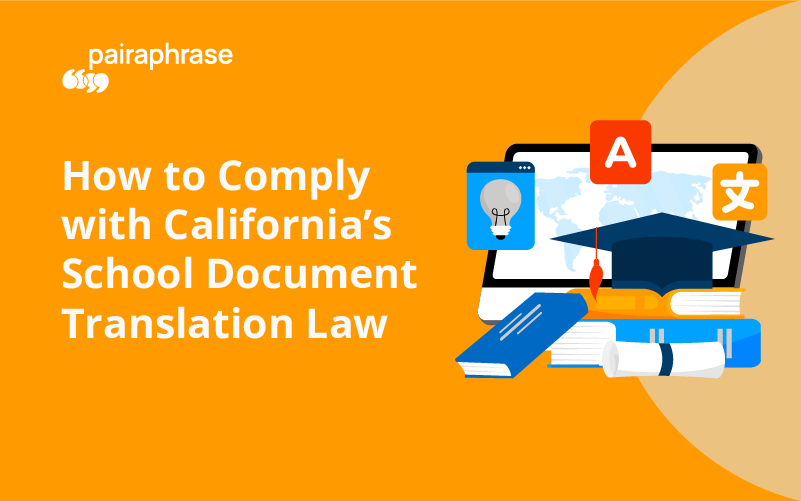Want to achieve compliance with California’s school document translation law? As an administrative staff member of a California K-12 school, you’re well aware of the necessity of clear and accessible communication within your educational system.
Compliance with The Golden State’s instituted requirements regarding document translation for K-12 schools is crucial for fostering inclusive learning environments. What’s more, it will bridge communication gaps with LEP (Limited English Proficiency) parents and students.
What You’ll Learn
In this guide, we'll outline essential steps and strategies for K-12 administrative staff to achieve compliance with California's school document translation law.
Please note: This guide is not intended to be used as legal advice.
Understanding California’s School Document Translation Law
According to the California Legislative Information website, Education Code section 48985 requires the translation of school documents for families of students who don't speak English when the count of students speaking a particular language reaches fifteen percent (15%) within the school's population.
In other words, it’s mandated that schools with significant populations of non-English speaking caregivers provide translated documents. This includes vital information such as enrollment forms, academic progress reports, disciplinary actions and other essential parent notifications.
The law requires translations in the primary languages spoken by the parents (or caregivers), ensuring that language barriers don't hinder parental engagement or student success.
Did You Know?
According to the California Department of Education, 81.90% of English learners in California schools are Spanish speakers. We suggest you check out our article on the Best Spanish Translator for School Districts.
Key Steps for Complying with California Education Code 48985
Here are some important steps toward compliance with California school translation requirements as they pertain to documents:
1. Identification of Languages
First, begin by identifying the primary languages spoken within your school community. A survey sent to families will help you to determine the languages requiring translation services.
2. Translation Plan Development
Next, develop a comprehensive plan detailing which documents need translation, the languages required and the frequency of updates. Prioritize high-impact materials such as IEP documents, enrollment forms, notices and academic reports.
3. Engage Internal Bilingual Staff
Once you develop a plan, engage internal bilingual staff who are proficient in the target languages. This should help you to ensure accuracy, cultural sensitivity and compliance with privacy regulations.
These staff can then use technology to help with translations (more on this later).
4. Implementation and Distribution
The next step is to execute the translation plan systematically. This will ensure timely translations of critical documents.
Additionally, you should distribute translated materials through multiple channels. This includes the school website, email communication and physical copies.
5. Compliance Review and Updates
Make sure you regularly review compliance status, update translated documents as needed and expand translation services for newly identified languages or revised documents.
Strategies for Successful Implementation
The following pointers will help you achieve successful implementation of your California school’s document translation plan.
Collaboration and Resource Allocation
Foster collaboration between administrative, teaching staff and translators. Allocate necessary resources for translation initiatives. This includes budget and time.
Utilize Technology
Leverage digital tools for efficient translation management. Look into translation management software and utilize AI-powered Machine Translation to drastically reduce hours spent translating school documents and achieve high-quality translations.
Culturally Responsive Translation
You’ll want to promote effective communication. Ensure translations consider cultural nuances, idiomatic expressions and context-specific language. This makes the world of a difference when it comes to caregiver involvement in a pupil’s education.
Training and Awareness
Train administrative school staff on the importance of compliance with California’s school translation requirements. Educate them on the benefits of culturally competent communication practices.
Benefits of Compliance with Education Code Section 48985
Achieving compliance with California's school document translation requirements will provide the following benefits:
- Fosters an inclusive environment
- Strengthens family-school partnerships
- Enhances parental engagement
- Facilitates effective communication
- Supports student success
- Ensures equitable access to vital information for all families
Conclusion
Adhering to the guidelines set forth in California education code 48985 is vital for K-12 schools to meet the diverse linguistic needs of their communities.
When you implement a robust translation plan, invest in translation software and foster a culture of inclusivity, your school can enhance communication, strengthen relationships and promote academic success for all students.
Compliance isn't just about meeting legal obligations; it's about building bridges and fostering a welcoming educational environment for every family.
Try Pairaphrase
Want to find a translation management system that helps your school with faster, safer and smarter translation of school documents?
Incorporate Pairaphrase into your plan for complying with California’s school translation law. It’s the AI-powered translation management system for schools that need to translate documents effectively. Pairaphrase translates 140+ languages, 20,000+ language pairs and 24 file types.

Get Started
or share this article with a colleague.________________________________________________
Related:


.png)

.png)




